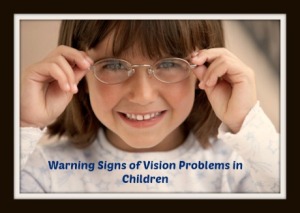While children with a family history of childhood vision problems are more likely to have eye problems themselves, all parents should know the warning signs of vision problems.

Babies Under 1 Year of Age
Babies older than 3 months should be able to follow or "track" an object, like a toy or ball, with their eyes as it moves across their field of vision. If your baby can't make steady eye contact by this time or seems unable to see, let your child's doctor know.
Before 4 months most babies eyes occasionally look misaligned (strabismus). However, after 4 months of age inward crossing or outward drifting that occurs regularly is usually abnormal. If one of these is present, let your child's doctor know.

Babies Under 1 Year of Age
Babies older than 3 months should be able to follow or "track" an object, like a toy or ball, with their eyes as it moves across their field of vision. If your baby can't make steady eye contact by this time or seems unable to see, let your child's doctor know.
Before 4 months most babies eyes occasionally look misaligned (strabismus). However, after 4 months of age inward crossing or outward drifting that occurs regularly is usually abnormal. If one of these is present, let your child's doctor know.
Preschool Age
If your child's eyes become misaligned, let your child's doctor know right away. However, vision problems such as a lazy eye (amblyopia) may have no warning signs, and your child may not complain of vision problems. Thus it's important at this time to have your child's vision checked. There are special tests to check your child's vision even if he or she cannot yet read.
It’s
always a good idea to get your child’s eyes checked on an annual or
bi-annual basis, but here are some signs you can look for that may
indicate that your child is having vision problems.
All Children
If you notice any one of the following, let your child's doctor know:- Eyes that are misaligned (look crossed, turn out, or don't focus together)
- White or grayish-white color in the pupil
- Eyes that flutter quickly from side to side or up and down
- Bulging eye(s)
- Child often complains of eye pain, itchiness, or discomfort
- Redness in either eye that doesn't go away in a few days
- Pus or crust in either eye
- Eyes that are always watery
- Drooping eyelid(s)
- Child rubs or squints eyes often
- Eyes that are always sensitive to light
- Any change in the eyes from how they usually look
- Gets headaches when reading or writing
- Words slide together or get blurry when reading
- Reads below grade level
- Loses place while reading
If your child is experiencing any of these problems, click here to schedule an appointment for an eye exam at through our convenient online scheduling feature.
Drop into 20/20 Eyeglass Superstore for all your child’s eye care needs. We have a frame for every face and a price for any budget. We also have Independent Optometrists located on site who will be happy to examine your child’s vision. Walk-in’s are welcome but we ask that you come 15 minutes prior to your desired appointment time.
No comments:
Post a Comment